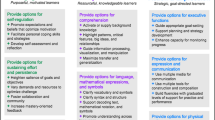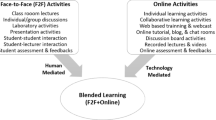Abstract
The purpose of this study was (a) to develop an instructional design model for preservice teachers’ learning of technological pedagogical content knowledge (TPACK) in multidisciplinary technology integration courses and (b) to apply the model to investigate its effects when used in a preservice teacher education setting. The model was applied in a technology integration course with fifteen participants from diverse majors. Data included individual participants’ written materials and TPACK survey responses, group lesson plans, and the researchers’ field notes. The data analysis results revealed that: (1) the participants had difficulties understanding pedagogical knowledge (PK), which hindered their learning of integrated knowledge of TPACK and (2) their learning of TPACK was the combination rather than the integration of PK, technological knowledge, and content knowledge. Suggestions and implications for refining the model and future research possibilities are discussed.

Similar content being viewed by others
Notes
Stand-alone courses refer to the courses that are not provided under specific methods or content courses or field experience courses for teacher candidates.
The assumption of this study was that preservice teachers should well understand the meaning of the three core domains (TK, PK, and CK) and then they can relate the understanding to integrative knowledge—the integrated domains of TPACK (e.g., PCK, TPK, TCK, and TPACK).
CK was defined as the knowledge that a teacher possesses for a deep understanding of her/his subject and the content standards of the subject. An example of CK given to participants: The knowledge of the events that led to Civil War.
PK was defined as the knowledge that a teacher possesses to understand and address students’ learning needs. An example of PK: Group discussion.
Technologies can be used as supportive tools in any subject area or topic for efficiency purposes. However, in this study, we emphasized effective use of technology for student learning than efficient use of technology for teachers.
References
Angeli, C. (2005). Transforming a teacher education method course through technology: Effects on preservice teachers’ technology competency. Computers & Education, 45(4), 383–398.
Angeli, C., & Valanides, N. (2005). Preservice elementary teachers as information and communication technology designers: An instructional systems design model based on an expanded view of pedagogical content knowledge. Journal of Computer Assisted Learning, 21(4), 292–302.
Association for Educational Communications and Technology (2012). AECT Standards, 2012 version. Retrieved June 26, 2014 from http://ocw.metu.edu.tr/pluginfile.php/3298/course/section/1171/AECT_Standards_adopted7_16_2.pdf.
Bandura, A. (1977). Social learning theory. Upper Saddle River, NJ: Prentice Hall.
Bers, M. U., Ponte, I., Juelich, C., Viera, A., Schenker, J., & AACE. (2002). Teachers as designers: Integrating robotics in early childhood education. Information Technology in Childhood Education Annual, 1, 123–145.
Bogdan, R. C., & Biklen, S. K. (2003). Qualitative research for education: An introduction to theories and methods (4th ed.). New York: Pearson Education group.
Davis, K. S., & Falba, C. J. (2002). Integrating technology in elementary preservice teacher education: orchestrating scientific inquiry in meaningful ways. Journal of Science Teacher Education, 13(4), 303–329.
Ertmer, P. A. (1999). Addressing first- and second-order barriers to change: Strategies for technology integration. Educational Technology Research and Development, 47(4), 47–61.
Ertmer, P. A. (2005). Teacher pedagogical beliefs: The final frontier in our quest for technology integration? Educational Technology Research and Development, 53(4), 25–40.
Fernández, M. L. (2005). Exploring “lesson study” in teacher preparation. In H. L. Chick & J. L. Vincent (Eds.), Proceedings of the 29th PME International Conference (Vol. 2, pp. 305–310). Melbourne.
Fernández, M. L. (2010). Investigating how and what prospective teachers learn through microteaching lesson study. Teaching and Teacher Education, 26, 351–362.
Gagné, R. M., Wager, W. W., Golas, K. C., & Keller, J. M. (2005). Principles of instructional design. Belmont, CA: Wadsworth/Thomson Learning.
Graham, R. C., Burgoyne, N., Cantrell, P., Smith, L., St. Clair, L., & Harris, R. (2009). Measuring the TPCK confidence of inservice science teachers. TechTrends, 53(5), 70–79.
Güler, C., & Altun, A. (2010). Teacher trainees as learning object designers: Problems and issues in learning object development process. Turkish Online Journal of Educational Technology - TOJET, 9(4), 118–127.
Gustafson, K. L., & Branch, R. M. (2002). What is instructional design? In R. A. Reiser & J. A. Dempsey (Eds.), Trends and issues in instructional design and technology (pp. 16–25). Saddle River, NJ: Merrill/Prentice-Hall.
Hall, G. E. (2010). Technology’s achilles heel: Achieving high-quality implementation. Journal of Research on Technology in Education, 42(3), 231–253.
Hew, K., & Brush, T. (2007). Integrating technology into K-12 teaching and learning: Current knowledge gaps and recommendations for future research. Educational Technology Research and Development, 55(3), 223–252.
Hjalmarson, M. A., & Diefes-Dux, H. A. (2008). Teacher as designer: A framework for the analysis of mathematical model-eliciting activities. The Interdisciplinary Journal of Problem-based Learning, 2(1), 57–78.
International Society for Technology in Education (ISTE) (2008). ISTE Standards. Retrieved June 26, 2014 from http://www.iste.org/docs/pdfs/20-14_ISTE_Standards-T_PDF.pdf.
Jang, S. J., & Chen, K. C. (2010). From PCK to TPACK: Developing a transformative model for preservice science teachers. Journal of Science Education and Technology, 19(6), 553–564.
Jang, S. J., Guan, S. Y., & Hsieh, H. F. (2009). Developing an instrument for assessing college students’ perceptions of teachers’ pedagogical content knowledge. Procedia Social and Behavioral Sciences, 1(1), 596–606.
Jimoyiannis, A. (2010). Developing a technological pedagogical content knowledge framework for science education: Implications of a teacher trainers’ preparation program. Proceedings of the Informing Science & IT Education Conference (In SITE 2010) (pp. 597–607). Cassino, Italy.
Jonassen, D. H. (2008). Instructional design as design problem solving: An iterative process. Educational Technology, 48(3), 21–26.
Kagan, D. M. (1992). Professional growth among preservice and beginning teachers. Review of Educational Research, 62, 129–170.
Kalantzis, M., & Cope, B. (2005). Learning by design. Melbourne: Victorian Schools Innovation Commission.
Kim, C., & Keller, J. M. (2011). Towards technology integration: The impact of motivational and volitional email messages. Educational Technology Research and Development, 59(1), 91–111.
Kim, M. C., Hannafin, M. J., & Bryan, L. A. (2007). Technology-enhanced inquiry tools in science education: An emerging pedagogical framework for classroom practice. Science Education, 91(6), 1010–1030.
Kim, C., Kim, M., Lee, C., Spector, J. M., & DeMeester, K. (2013). Teacher beliefs and technology integration. Teaching and Teacher Education, 29, 76–85.
Koehler, M. J., & Mishra, P. (2005). Teachers learning technology by design. Journal of Computing in Teacher Education, 21(3), 94–102.
Koehler, M. J., & Mishra, P. (2009). What is technological pedagogical content knowledge? Contemporary Issues in Technology and Teacher Education, 9(1), 60–70.
Koehler, M. J., Mishra, P., & Yahya, K. (2007). Tracing the development of teacher knowledge in a design seminar: Integrating content, pedagogy, & technology. Computers & Education, 49(3), 740–762.
Mayring, P. (2000). Qualitative content analysis. Forum: Qualitative Social Research, 1(2). Retrieved June 26, 2014 from http://217.160.35.246/fqs-texte/2-00/2-00mayring-e.pdf.
Merriam, S. B. (1995). What can you tell from an N of 1? Issues of validity and reliability in qualitative research. PAACE Journal of Lifelong Learning, 4, 51–60.
Merrill, M. D. (2002). First principles of instruction. Educational Technology Research and Development, 50(3), 43–59.
Merrill, M. D. (2007). The future of instructional design: the proper study of instructional design. In R. A. Reiser & J. V. Dempsey (Eds.), Trends and issues in instructional design and technology (2nd ed., pp. 336–341). Upper Saddle River, NJ: Pearson Education Inc.
Merrill, M. D. (2009). First principles of instruction. In C. M. Reigeluth & A. Carr (Eds.), Instructional design theories and models: Building a common knowledge base (Vol. III). New York: Routledge Publishers.
Mishra, P., & Koehler, M. J. (2006). Technological pedagogical content knowledge: A new framework for teacher knowledge. Teachers College Record, 108(6), 1017–1054.
National Center for Education Statistics (NCES). (2008). Educational technology in teacher education programs for initial licensure. Retrieved June 26, 2014 from http://nces.ed.gov/pubs2008/2008040.pdf.
National Science Teachers Association (NSTA). (2003). Standards for science teacher preparation. Retrieved June 26, 2014 from http://www.nsta.org/preservice/docs/NSTAstandards2003.pdf.
Niess, M. L. (2005). Preparing teachers to teach science and mathematics with technology: developing a technology pedagogical content knowledge. Teaching and Teacher Education, 21, 509–523.
Polly, D., McGee, J. R., & Sullivan, C. (2010a). Employing technology-rich mathematical tasks to develop teachers’ technological, pedagogical, and content knowledge (TPACK). Journal of Computers in Mathematics and Science Teaching, 29(4), 455–472.
Polly, D., Mims, C., Shepherd, C. E., & Inan, F. (2010b). Evidence of impact: transforming teacher education with preparing tomorrow’s teachers to teach with technology. Teaching and Teacher Education, 26, 863–870.
Sahin, I. (2011). Development of survey of technological pedagogical and content knowledge (TPACK). Turkish Online Journal of Educational Technology, 10(1), 97–105.
Sandholtz, J. H., Ringstaff, C., & Dwyer, D. C. (1997). Teaching with technology: Creating student-centered classrooms. New York: Teachers College Press.
Schmidt, D., Baran, E., Thompson, A., Koehler, M. J., Shin, T, & Mishra, P. (2009). Technological pedagogical content knowledge (TPACK): The development and validation of an assessment instrument for preservice teachers. Paper presented at the 2009 Annual Meeting of the American Educational Research Association. April 13–17, San Diego, California.
Seel, N. M. (2003). Model-centered learning and instruction. Technology, Instruction, Cognition and Learning, 1(1), 59–85.
Shulman, L. (1987). Knowledge and teaching: Foundations of the new reform. Harvard Educational Review, 57(1), 1–22.
Shute, V. J., Jeong, A. C., Spector, J. M., Seel, N. M., & Johnson, T. E. (2009). Model-based methods for assessment, learning, and instruction: Innovative educational technology at Florida State University. In M. Orey, V. J. McClendon, & R. Branch (Eds.), Educational media and technology yearbook (p. 61). Westport, CT: Greenwood Publishing Group.
Simons, H. (2009). Case study research in practice. Los Angeles, CA: Sage.
Spradley, J. P. (1980). Participant observation. Fort Worth, TX: Harcourt Brace College Publishers.
Thompson, A. D., & Mishra, P. (2007). Breaking news: TPCK becomes TPACK! Journal of Computing in Teacher Education, 24(2), 38.
Tschannen-Moran, M., & Woolfolk Hoy, A. (2001). Teacher efficacy: Capturing and elusive construct. Teaching and Teacher Education, 17, 783–805.
Voogt, J., Tilya, F., & Van den Akker, J. (2009). Science teacher learning for MBL-supported student-centered science education in the context of secondary education in Tanzania. Journal of Science and Education and Technology, 18, 428–429.
Williams, M., Linn, M. C., Ammon, P., & Gearhart, M. (2004). Learning to teach inquiry science in a technology-based environment: A case study. Journal of Science Education and Technology, 13(2), 189–206.
Wolcott, H. (1994). Transforming qualitative data: Description, analysis and interpretation. Thousand Oaks, CA: Sage.
Yoon, F. S., Ho, J., & Hedberg, J. G. (2006). Teachers as designers of learning environments. Computers in the Schools, 22(3/4), 145–157.
Author information
Authors and Affiliations
Corresponding author
Rights and permissions
About this article
Cite this article
Lee, CJ., Kim, C. An implementation study of a TPACK-based instructional design model in a technology integration course. Education Tech Research Dev 62, 437–460 (2014). https://doi.org/10.1007/s11423-014-9335-8
Published:
Issue Date:
DOI: https://doi.org/10.1007/s11423-014-9335-8




